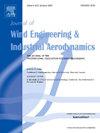Mixture Gram–Charlier series method for modelling wind velocity probability distribution in actual urban environments
IF 4.9
2区 工程技术
Q1 ENGINEERING, CIVIL
Journal of Wind Engineering and Industrial Aerodynamics
Pub Date : 2025-07-12
DOI:10.1016/j.jweia.2025.106172
引用次数: 0
Abstract
Understanding probabilistic features in urban wind environments is crucial. While previous studies have used the Gram–Charlier series (GCS) method to model the probability distribution functions (PDFs) of wind speed, their accuracy is often limited for bimodal or highly-skewed PDFs. This issue becomes more pronounced when large moments cause fluctuations in the modeled PDFs. This study introduces the mixture GCS method for modeling the PDFs of wind velocity components and wind speed. Time-series data derived from a large eddy simulation (LES) of an actual urban area (Niigata City, Japan), were analyzed. This study focuses on two mixture GCS methods: GCS2-2 (combining two Gaussian distributions) and GCS2-3 (combining a Gaussian distribution and a third-order GCS model). While GCS methods effectively model symmetric PDFs, the mixture GCS methods excel at capturing bimodal and skewed PDFs, with GCS2-3 proving more accurate than GCS2-2. Compared to GCS-6th, GCS2-3 achieves a more accurate maximum mean absolute error (), reducing it by over 50%. For nearly symmetric unimodal PDFs, traditional GCS methods suffice, but for cases with large higher-order moments, mixture GCS methods are recommended to avoid accuracy loss. This study is expected to provide valuable insights for probabilistic modeling of urban wind environments.
混合Gram-Charlier级数法模拟实际城市环境中风速概率分布
了解城市风环境的概率特征是至关重要的。虽然以前的研究使用了Gram-Charlier级数(GCS)方法来模拟风速的概率分布函数(pdf),但它们的精度往往受到双峰或高度倾斜的pdf的限制。当大力矩导致建模pdf中的波动时,这个问题变得更加明显。本文介绍了混合GCS方法对风速分量和风速的pdf进行建模。对日本新泻市实际城区大涡模拟(LES)的时序数据进行了分析。本研究重点研究了两种混合GCS方法:GCS2-2(结合两个高斯分布)和GCS2-3(结合高斯分布和三阶GCS模型)。虽然GCS方法有效地模拟对称pdf,但混合GCS方法在捕获双峰和倾斜pdf方面表现出色,其中GCS2-3证明比GCS2-2更准确。与gcs -6相比,GCS2-3获得了更精确的最大平均绝对误差(MAE),减少了50%以上。对于几乎对称的单峰pdf,传统的GCS方法就足够了,但对于高阶矩较大的情况,建议使用混合GCS方法以避免精度损失。该研究有望为城市风环境的概率建模提供有价值的见解。
本文章由计算机程序翻译,如有差异,请以英文原文为准。
求助全文
约1分钟内获得全文
求助全文
来源期刊
CiteScore
8.90
自引率
22.90%
发文量
306
审稿时长
4.4 months
期刊介绍:
The objective of the journal is to provide a means for the publication and interchange of information, on an international basis, on all those aspects of wind engineering that are included in the activities of the International Association for Wind Engineering http://www.iawe.org/. These are: social and economic impact of wind effects; wind characteristics and structure, local wind environments, wind loads and structural response, diffusion, pollutant dispersion and matter transport, wind effects on building heat loss and ventilation, wind effects on transport systems, aerodynamic aspects of wind energy generation, and codification of wind effects.
Papers on these subjects describing full-scale measurements, wind-tunnel simulation studies, computational or theoretical methods are published, as well as papers dealing with the development of techniques and apparatus for wind engineering experiments.

 求助内容:
求助内容: 应助结果提醒方式:
应助结果提醒方式:


